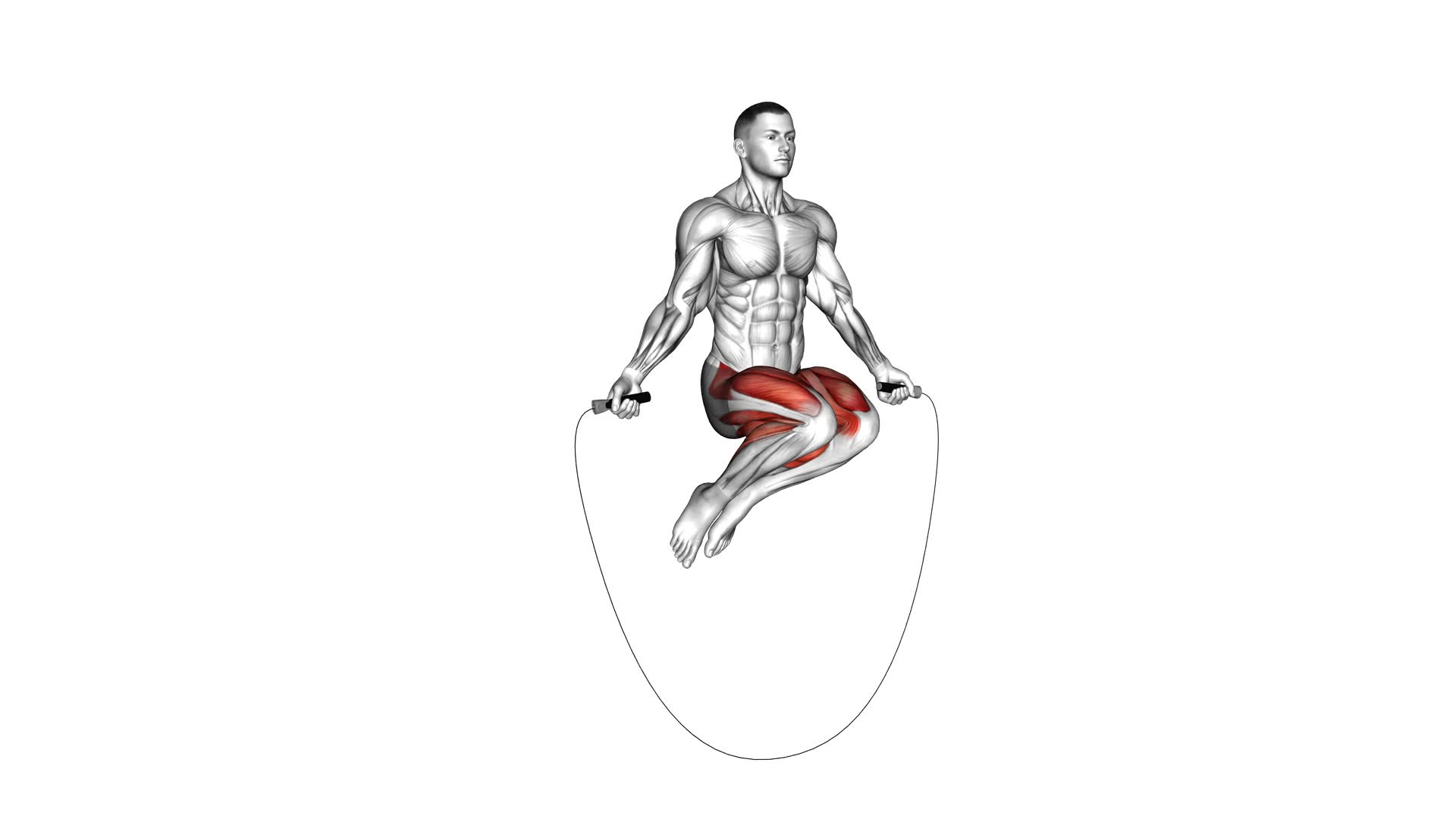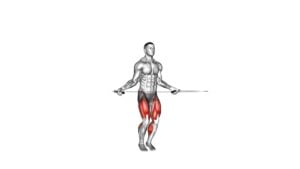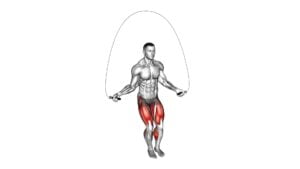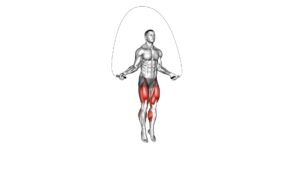High Jump Rope (male) – Video Exercise Guide & Tips

Are you ready to take your jump rope skills to the next level? Look no further!
Watch This Exercise Video
This video exercise guide and tips for high jump rope (male) will give you the knowledge and techniques you need to maximize your performance.
From proper technique to advanced moves, you'll find everything you need to challenge yourself and avoid common mistakes.
Get ready to incorporate high jump rope into your workout routine and see the results you've been striving for.
Let's jump into it!
Key Takeaways
- High jump rope improves cardiovascular health and engages multiple muscle groups
- Proper technique, including posture and wrist power, maximizes performance
- Advanced jump rope moves challenge and improve agility and coordination
- Avoiding common mistakes, such as maintaining a neutral spine and relaxed wrists, prevents injuries
Benefits of High Jump Rope for Men
There are five key benefits of high jump rope for men that you can experience.
Jumping rope is a fantastic way to improve your cardiovascular health. It gets your heart pumping and increases your heart rate, leading to improved circulation and a stronger cardiovascular system.
In addition, high jump rope also helps in increasing agility and coordination. The constant jumping and footwork required in jump rope exercises help to enhance your coordination skills and improve your overall agility. By incorporating jump rope into your fitness routine, you can develop better balance and body control.
Jumping rope is a highly effective form of exercise that engages multiple muscle groups, including your arms, shoulders, core, and legs. It can help to build strength and endurance throughout your entire body.
Furthermore, high jump rope is a great way to burn calories and lose weight. It's a high-intensity workout that can help you torch calories and shed unwanted pounds.
In the next section, we'll discuss proper jump rope technique for maximum performance. By mastering the right technique, you can maximize the benefits of high jump rope and minimize the risk of injury. So let's dive into the details of how to jump rope effectively and efficiently.
Proper Jump Rope Technique for Maximum Performance
To maximize your performance in high jump rope, it's crucial to master the proper technique for jumping rope effectively and efficiently. By following these jump rope technique tips, you can enhance your workout and reap the benefits of this dynamic exercise.
- Maintain proper posture: Stand tall with your shoulders relaxed and your core engaged. Keep your elbows close to your sides and wrists relaxed. This alignment will allow for better control and efficiency in your jumps.
- Use your wrists, not your arms: The power in your jump should come from your wrists, not from big arm movements. Focus on rotating the rope with a flick of your wrists, keeping your arms relaxed and close to your body.
- Land softly and lightly: When jumping, aim to land on the balls of your feet, not your heels. This reduces impact on your joints and allows for a more efficient transfer of energy. Keep your jumps light and springy, minimizing the time your feet spend on the ground.
Advanced Jump Rope Moves to Challenge Yourself
To challenge yourself further in high jump rope, take your skills to the next level with advanced jump rope moves that will push your limits and test your agility.
These jump rope tricks aren't only impressive to watch but also require a high level of skill and coordination. They're commonly seen in jump rope competitions where athletes showcase their abilities and creativity.
One advanced move to try is the double under. This involves spinning the rope twice under your feet with a single jump. It requires precise timing and a quick jump to clear the rope twice.
Another challenging move is the criss-cross, where you cross your arms in front of your body while jumping, creating an X shape with the rope. This move requires coordination and control to avoid getting tangled in the rope.
As you master these advanced jump rope moves, you won't only improve your agility and coordination but also gain confidence in your abilities. These tricks can be incorporated into your regular jump rope routine to add variety and challenge.
Now, let's move on to some tips for avoiding common mistakes in high jump rope.
Tips for Avoiding Common Mistakes in High Jump Rope
Avoid common mistakes in high jump rope by focusing on proper form and technique. By following these tips, you can avoid injuries and improve your coordination:
- Maintain a neutral spine: Keep your back straight and avoid rounding your shoulders. This will help prevent strain on your back and neck.
- Land softly: When you jump, aim to land softly on the balls of your feet. This will reduce the impact on your joints and lower the risk of injury.
- Keep your wrists relaxed: Avoid gripping the handles of the jump rope too tightly. Instead, maintain a relaxed grip to prevent strain on your wrists and forearms.
By paying attention to these details, you can ensure that you're performing high jump rope exercises correctly and safely. Focusing on proper form will reduce the risk of injuries such as sprained ankles or wrist strain.
Additionally, improving your coordination will help you to jump more efficiently and effectively, allowing you to achieve better results from your workouts. Remember, practice makes perfect, so take your time to master these techniques and enjoy your high jump rope workouts while staying injury-free.
Incorporating High Jump Rope Into Your Workout Routine
To effectively incorporate high jump rope into your workout routine, start by determining the appropriate frequency and duration for your sessions. High jump rope is a great addition to your cardio routine, as it offers numerous benefits. It improves your cardiovascular endurance, helping you to burn calories and lose weight. Jumping rope also enhances coordination, agility, and balance. It targets multiple muscle groups, including your calves, hamstrings, and shoulders.
When starting out, begin with shorter sessions, around 5-10 minutes, and gradually increase the duration as you build endurance. Aim to jump rope at least 3-4 times a week to reap the maximum benefits. As you progress in your high jump rope skills, you can try different variations and techniques to challenge yourself. Start with basic jumps, then move on to single leg jumps, double unders, and even tricks like crossovers and criss-crosses.
Remember to warm up before each session and cool down afterward to prevent injuries. Incorporating high jump rope into your workout routine won't only make your cardio workouts more fun and engaging but also help you achieve your fitness goals faster.
Frequently Asked Questions
How Long Should I Jump Rope for Each Session?
To determine the ideal jump rope duration for each session, consider your fitness level and goals. Jumping rope for 10-15 minutes can be a good starting point. As you progress, aim for 20-30 minutes, but listen to your body and avoid overexertion.
The best time to jump rope during a workout is usually at the beginning or as part of a cardio circuit. Remember to warm up, maintain proper form, and gradually increase your jump rope duration over time.
What Are Some Common Injuries Associated With High Jump Rope?
Common injuries associated with high jump rope include sprained ankles, shin splints, and knee pain. To prevent these injuries, it's important to wear proper footwear and warm up before jumping rope.
Incorporating strength and flexibility exercises into your routine can also help improve stability and reduce the risk of injury. Remember to listen to your body and take breaks when needed.
Can High Jump Rope Help With Weight Loss?
High jump rope can be an effective exercise for weight loss. By incorporating high jump rope techniques into your workout routine, you can burn a significant amount of calories and increase your cardiovascular health.
The repetitive jumping motion engages multiple muscle groups, helping to tone and strengthen your body. Additionally, high jump rope provides a high-intensity workout, which can boost your metabolism and aid in weight loss.
Is It Better to Jump Rope Before or After Weightlifting?
Jumping rope before weightlifting has its benefits. It serves as a pre-workout activity, warming up your muscles and increasing your heart rate, which can improve your performance during weightlifting.
On the other hand, jumping rope after weightlifting offers post-workout benefits. It helps with cooldown, stretching your muscles, and aiding in recovery.
Both options have their advantages, so choose what works best for you and your fitness goals.
How Often Should I Incorporate High Jump Rope Into My Workout Routine?
To maximize the benefits of high jump rope, it's important to incorporate it into your workout routine regularly.
The frequency of high jump rope depends on your fitness level and goals. A good starting point is to aim for 2-3 sessions per week.
This will help improve cardiovascular fitness, burn calories, and strengthen your leg muscles.
As you progress, you can increase the frequency to challenge yourself and continue reaping the benefits of this effective exercise.
Conclusion
In conclusion, high jump rope is a beneficial exercise for men that can improve cardiovascular fitness, coordination, and agility.
By mastering proper jump rope technique and incorporating advanced moves, men can challenge themselves and enhance their performance.
However, it's important to avoid common mistakes to prevent injury and maximize results.
Adding high jump rope to your workout routine can provide a fun and effective way to stay fit and achieve your fitness goals.

Author
Years ago, the spark of my life’s passion ignited in my mind the moment I stepped into the local gym for the first time. The inaugural bead of perspiration, the initial endeavor, the very first surge of endorphins, and a sense of pride that washed over me post-workout marked the beginning of my deep-seated interest in strength sports, fitness, and sports nutrition. This very curiosity blossomed rapidly into a profound fascination, propelling me to earn a Master’s degree in Physical Education from the Academy of Physical Education in Krakow, followed by a Sports Manager diploma from the Jagiellonian University. My journey of growth led me to gain more specialized qualifications, such as being a certified personal trainer with a focus on sports dietetics, a lifeguard, and an instructor for wellness and corrective gymnastics. Theoretical knowledge paired seamlessly with practical experience, reinforcing my belief that the transformation of individuals under my guidance was also a reflection of my personal growth. This belief holds true even today. Each day, I strive to push the boundaries and explore new realms. These realms gently elevate me to greater heights. The unique combination of passion for my field and the continuous quest for growth fuels my drive to break new ground.



